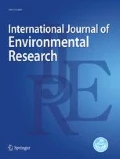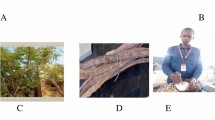Abstract
One of the most noticeable steps in the microalgae biomass production is the harvesting of cells from a very dilute slurry culture medium, which accounts for 20–30% of the whole process operating cost. In the present study, Chlorella vulgaris microalgae of the Persian Gulf, as a type of stable colloidal particles, were initially cultivated in an f/2 culture medium. The dispersed biomass was then harvested using the methods of autoflocculation–sedimentation in the jar test setup and electrocoagulation–flotation in a laboratory-scale horizontal electrodes’ plexiglass container. In this regard, the affecting factors on their harvesting efficiency were optimized and modelled applying response surface methodology. Considering the autoflocculation–sedimentation process and design of experiments results, the maximum harvesting efficiency of 66.00% was obtained under optimum conditions of pH = 12, mixing rate of 20 rpm, and 30 min sedimentation time. In the electrocoagulation–flotation under the optimum conditions of pH = 8.00 and 4.00 v/cm, DC electric field intensity between aluminium electrodes, the harvesting efficiency of 99.55% was achieved within 6 min. However, under the same operating conditions, for the first time in this study, by replacing the aluminium electrodes with the carbon cloth covered by a thin layer of filter paper as the anode, and the stainless-steel cathode, the 98.00% flotation efficiency was attained. Compared to the aluminium electrodes, the carbon cloth/stainless-steel set exhibited the lowest pollution, due to less electrodes’ corrosion.
Graphical abstract

Article Highlights
-
Chlorella vulgaris microalgae of the Persian Gulf was initially cultivated.
-
Autoflocculation-sedimentation and ECF were used for harvesting of microalgae.
-
Affecting factors on harvesting efficiency were modelled applying RSM.
-
In autoflocculation maximum harvesting was 66.00% at pH=12, within 30 min.
-
In ECF with Al-anode maximum harvesting was 99.55% at pH=9, within 6 min.
-
In ECF with carbon cloth anode harvesting was 98% but fewer ion contamination.






Similar content being viewed by others
Data Availability
Available on request.
References
An J, Li N, Wang S, Liao C, Zhou L, Li T, Wang X, Feng Y (2019) A novel electro-coagulation-Fenton for energy efficient cyanobacteria and cyanotoxins removal without chemical addition. J Hazard Mater 365:650–658
Besson A, Guiraud P (2013) High-pH-induced flocculation–flotation of the hypersaline microalga Dunaliella salina. Biores Technol 147:464–470
Chatsungnoen T, Chisti Y (2019) Flocculation and electroflocculation for algal biomass recovery. In: Pandey A, Chang S, Soccol C, Lee D, Chisti Y (eds) Biofuels from Algae, vol 1, 2nd edn. Elsevier, Amsterdam, The Netherlands, pp 257–286
Chen C-Y, Yeh K-L, Aisyah R, Lee D-J, Chang J-S (2011) Cultivation, photobioreactor design and harvesting of microalgae for biodiesel production: a critical review. Biores Technol 102:71–81
Farooq W, Suh WI, Park MS, Yang J-W (2015) Water use and its recycling in microalgae cultivation for biofuel application. Biores Technol 184:73–81
Fayad N, Yehya T, Audonnet F, Vial C (2017) Harvesting of microalgae Chlorella vulgaris using electro-coagulation-flocculation in the batch mode. Algal Res 25:1–11
Gao S, Yang J, Tian J, Ma F, Tu G, Du M (2010) Electro-coagulation–flotation process for algae removal. J Hazard Mater 177:336–343
García-Pérez JS, Beuckels A, Vandamme D, Depraetere O, Foubert I, Parra R, Muylaert K (2014) Influence of magnesium concentration, biomass concentration and pH on flocculation of Chlorella vulgaris. Algal Res 3:24–29
Gomes JA, Daida P, Kesmez M, Weir M, Moreno H, Parga JR, Irwin G, McWhinney H, Grady T, Peterson E (2007) Arsenic removal by electrocoagulation using combined Al–Fe electrode system and characterization of products. J Hazard Mater 139:220–231
Guldhe A, Misra R, Singh P, Rawat I, Bux F (2016) An innovative electrochemical process to alleviate the challenges for harvesting of small size microalgae by using non-sacrificial carbon electrodes. Algal Res 19:292–298
Hashemian M, Ahmadzadeh H, Hosseini M, Lyon S, Pourianfar HR (2019) Production of microalgae-derived high-protein biomass to enhance food for animal feedstock and human consumption. In: Majid BT (ed) Advanced bioprocessing for alternative fuels hosseini biobased chemicals, and bioproducts, Chap 20. Woodhead Publishing Series in Energy, pp 393–405. https://doi.org/10.1016/B978-0-12-817941-3.00020-6
Kim D-G, La H-J, Ahn C-Y, Park Y-H, Oh H-M (2011) Harvest of Scenedesmus sp. with bioflocculant and reuse of culture medium for subsequent high-density cultures. Biores Technol 102:3163–3168
Kim J, Ryu B-G, Kim B-K, Han J-I, Yang J-W (2012) Continuous microalgae recovery using electrolysis with polarity exchange. Biores Technol 111:268–275
Landels A, Beacham TA, Evans CT, Carnovale G, Raikova S, Cole IS, Goddard P, Chuck C, Allen MJ (2019) Improving electrocoagulation floatation for harvesting microalgae. Algal Res 39:101446
Liu S, Hajar HAA, Riefler G, Stuart BJ (2018) Investigation of electrolytic flocculation for microalga Scenedesmus sp. using aluminum and graphite electrodes. RSC Adv 8:38808–38817
Luo S, Griffith R, Li W, Peng P, Cheng Y, Chen P, Addy MM, Liu Y, Ruan R (2017) A continuous flocculants-free electrolytic flotation system for microalgae harvesting. Biores Technol 238:439–449
Milledge JJ, Heaven S (2013) A review of the harvesting of micro-algae for biofuel production. Rev Environ Sci Bio/Technol 12:165–178
Mouedhen G, Feki M, Wery MDP, Ayedi H (2008) Behavior of aluminum electrodes in electrocoagulation process. J Hazard Mater 150:124–135
Nayak M, Rashid N, Suh WI, Lee B, Chang YK (2019) Performance evaluation of different cationic flocculants through pH modulation for efficient harvesting of Chlorella sp. HS2 and their impact on water reusability. Renew Energ 136:819–827
Nguyen TDP, Le TVA, Show PL, Nguyen TT, Tran MH, Tran TNT, Lee SY (2019) Bioflocculation formation of microalgae-bacteria in enhancing microalgae harvesting and nutrient removal from wastewater effluent. Biores Technol 272:34–39
Okoro V, Azimov U, Munoz J, Hernandez HH, Phan AN (2019) Microalgae cultivation and harvesting: Growth performance and use of flocculants-A review. Renew Sustain Energ Rev 115:109364
Pandey A, Pathak VV, Kothari R, Black PN, Tyagi V (2019) Experimental studies on zeta potential of flocculants for harvesting of algae. J Environ Manage 231:562–569
Pérez L, Salgueiro JL, Maceiras R, Cancela Á, Sánchez Á (2017) An effective method for harvesting of marine microalgae: pH induced flocculation. Biomass Bioenerg 97:20–26
Pleissner D, Lam WC, Sun Z, Lin CSK (2013) Food waste as nutrient source in heterotrophic microalgae cultivation. Biores Technol 137:139–146
Rahmani A, Zerrouki D, Djafer L, Ayral A (2017) Hydrogen recovery from the photovoltaic electroflocculation-flotation process for harvesting Chlorella pyrenoidosa microalgae. Int J Hydrogen Energ 42:19591–19596
Razack SA, Duraiarasan S, Shellomith AS, Muralikrishnan K (2015) Statistical optimization of harvesting Chlorella vulgaris using a novel bio-source, Strychnos potatorum. Biotechnol Rep 7:150–156
Ryu B-G, Kim J, Han J-I, Kim K, Kim D, Seo B-K, Kang C-M, Yang J-W (2018) Evaluation of an electro-flotation-oxidation process for harvesting bio-flocculated algal biomass and simultaneous treatment of residual pollutants in coke wastewater following an algal-bacterial process. Algal Res 31:497–505
Shi W, Zhu L, Chen Q, Lu J, Pan G, Hu L, Yi Q (2017) Synergy of flocculation and flotation for microalgae harvesting using aluminium electrolysis. Bioresour Technol 233:127–133
Sirajunnisa AR, Surendhiran D (2016) Algae–A quintessential and positive resource of bioethanol production: a comprehensive review. Renew Sustain Energy Rev 66:248–267
Smith BT, Davis RH (2012) Sedimentation of algae flocculated using naturally-available, magnesium-based flocculants. Algal Res 1:32–39
Smith L, Fox J, Granvil D (1993) Intensive algae culture techniques. CRC Handb Maric 1:3–13
Ummalyma SB, Mathew AK, Pandey A, Sukumaran RK (2016) Harvesting of microalgal biomass: efficient method for flocculation through pH modulation. Biores Technol 213:216–221
Vandamme D, Foubert I, Fraeye I, Meesschaert B, Muylaert K (2012) Flocculation of Chlorella vulgaris induced by high pH: role of magnesium and calcium and practical implications. Biores Technol 105:114–119
Wu Z, Zhu Y, Huang W, Zhang C, Li T, Zhang Y, Li A (2012) Evaluation of flocculation induced by pH increase for harvesting microalgae and reuse of flocculated medium. Biores Technol 110:496–502
Zheng H, Zhu G, Jiang S, Tshukudu T, Xiang X, Zhang P, He Q (2011) Investigations of coagulation–flocculation process by performance optimization, model prediction and fractal structure of flocs. Desalination 269:148–156
Acknowledgment
The authors would like to gratefully acknowledge support of the Aquaculture Department of Persian Gulf and Oman Sea Ecology Research Institute for providing the Chlorella vulgaris microalgae pre-cultures.
Author information
Authors and Affiliations
Contributions
Prof. A. Samimi, as the second author and corresponding author, was responsible for integrity of the research work as whole from inception to finished article. He designed the concept of study and supervised Ms Pishgar (first author and the postgraduate student) as her first supervisor. He prepared the logistic and administrative support for carrying out the research and obtaining of funding. Professor Samimi also revised critically the article for intelectual content and approved its final version for submission. Ms Z. Pishgar carried out the research through setting up the instruments, performing the experiments, collecting the data, and interpreting them, as well as writing the first draft of the article under supervision of her supervisors. Dr. D. Mohebbi as the third author and second supervisor of the postgraduate student (Ms Pishgar) was mostly responsible for supervising the student in analyzing and interpretation of the statistical data. The article’s draft was also reviewed by Dr. Mohebbi for presenting his comments before submission. Dr. S. Shokrollahzadeh as the forth author and the advisor of Ms Pishgar was responsible for giving scientific advice to her and supervisors and reviewing the article before submission. As a environmental reseracher she had a good contribution in this study.
Corresponding author
Ethics declarations
Conflict of Interest
On behalf of all authors, the corresponding author states that there is no conflict of interest.
Rights and permissions
About this article
Cite this article
Pishgar, Z., Samimi, A., Mohebbi-Kalhori, D. et al. Comparative Study on the Harvesting of Marine Chlorella vulgaris Microalgae from a Dilute Slurry Using Autoflocculation-Sedimentation and Electrocoagulation-Flotation Methods. Int J Environ Res 14, 615–628 (2020). https://doi.org/10.1007/s41742-020-00277-y
Received:
Revised:
Accepted:
Published:
Issue Date:
DOI: https://doi.org/10.1007/s41742-020-00277-y




